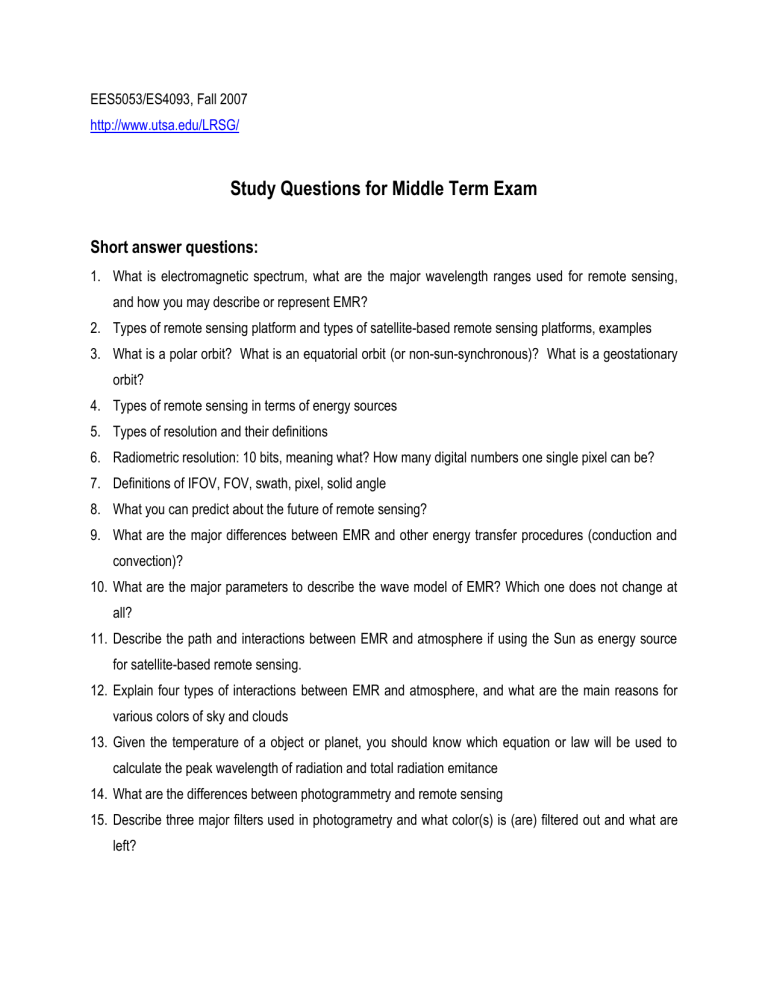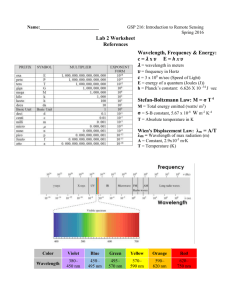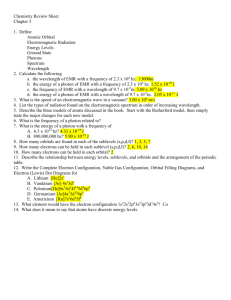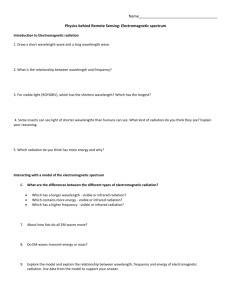doc

EES5053/ES4093, Fall 2007 http://www.utsa.edu/LRSG/
Study Questions for Middle Term Exam
Short answer questions:
1.
What is electromagnetic spectrum, what are the major wavelength ranges used for remote sensing, and how you may describe or represent EMR?
2.
Types of remote sensing platform and types of satellite-based remote sensing platforms, examples
3.
What is a polar orbit? What is an equatorial orbit (or non-sun-synchronous)? What is a geostationary orbit?
4.
Types of remote sensing in terms of energy sources
5.
Types of resolution and their definitions
6.
Radiometric resolution: 10 bits, meaning what? How many digital numbers one single pixel can be?
7.
Definitions of IFOV, FOV, swath, pixel, solid angle
8.
What you can predict about the future of remote sensing?
9.
What are the major differences between EMR and other energy transfer procedures (conduction and convection)?
10.
What are the major parameters to describe the wave model of EMR? Which one does not change at all?
11.
Describe the path and interactions between EMR and atmosphere if using the Sun as energy source for satellite-based remote sensing.
12.
Explain four types of interactions between EMR and atmosphere, and what are the main reasons for various colors of sky and clouds
13.
Given the temperature of a object or planet, you should know which equation or law will be used to calculate the peak wavelength of radiation and total radiation emitance
14.
What are the differences between photogrammetry and remote sensing
15.
Describe three major filters used in photogrametry and what color(s) is (are) filtered out and what are left?
16.
Know how to calculate a scale if given the length of an object in the photo and the length of the object in the real world.
17.
what are the 3 additive primary colors and 3 subtractive primary colors
18.
In photogrammetry, why we need to do orthorectification and what it does.
19.
Define the following: Radiance, transmittance, absorptance, irradiance and exitance, spectral reflectance and albedo, Which of these does a remote sensor directly measure?
20.
What is the defining characteristic of a perfect specular reflector or a perfect diffuse reflector (or
Lambertian surface)?
21.
Emissions from the earth are in which part of the electro-magnetic spectrum? Thermal infrared emitted from room temperature objects is maximum around what wavelength?
22.
Draw the typical reflectance vs wavelength plot for a green leaf, label the two chlorophyll absorption bands and the two water absorption bands.
23.
Which part of the spectrum is maximally reflected/scattered by green vegetation?
24.
How NDVI is defined and what information the NDVI can tell?
25.
what is difference among true color, false color, and false color infrared images
26.
The index of refraction depends upon what? Given the index of air is 1.0, water is 1.3, which direction you can predict the light will go (use a figure to illustrate) if the light direction is 30 ° from the vertical?
27.
What color is the wavebands operating at 0.44 micrometers? 0.55 micrometers? 0.65 micrometers?
28.
There are different types of remote detector configurations. We can classify them into two groups: whiskbroom and pushbroom, or across track and along track (give one or two sensor examples for each type). Explain what they are and their relationships. What is the dwell time? Which type has longer dwell time? What longer dwell time means?
29.
While linear array and area array configurations are mostly used in imaging spectrometry, they can be either whiskbroom or pushbroom. Give one or two sensor examples of each type. What is the imaging spectrometry?
30.
What is the major difference between multiple spectral remote sensing and hyperspectral remote sensing?
31.
What is the major difference between thermal infrared remote sensing (3 -100 µm) and visible and near infrared (0.4 – 2.5 µm) based remote sensing.
32.
what is digital image processing. It includes:
33.
for a single band image, what type statistics parameters we usually look at. For multi-band image, to look at the interrelationship between images, we statistic parameters we use. In the following correlation figure, how you explain the relationship between those 4 bands:
Band 1 Band 2 Band 3 Band 4
Band 1 - -
Band 2 0.35 -
-
-
-
-
Band 3 0.95 0.53 - -
Band 4 0.94 0.16 0.87 -
34.
why we want to atmospheric correction to the image and what is the difference between absolute atmospheric correction and relative atmospheric correction
35.
what is the geometric correction, which two types of interpolation happen when doing geometric corrections
36.
major difference between unsupervised and supervised classifications, major difference between hard and fuzzy classifications, and major difference between pixel-based and object-oriented classifications
37.
what is change diction?
True or False:
1.
When an electro-magnetic wave enters a denser medium, the wave bends away from the normal.
2.
Chlorophyll in green vegetation absorbs mainly in the visible region of the EMR spectrum.
3.
The blue color of sky is a result of scattering of blue color waves.
4.
When an electron absorbs energy from a photon, it jumps to a lower energy level.
5.
Microwaves are more powerful than ultra-violet waves.
6.
The energy in one photon depends upon its wavelength.
7.
Hyper spectral sensors usually have 4 spectral bands.
8.
Compare with most of the Earth surface, water is warmer during the night and cooler during the day
9.
All bodies radiate
10.
Hotter bodies radiate more at all wavelengths
11.
Radiation from a hotter body peaks at a longer wavelength than from a cooler body
12.
A good absorber is a good emitter
13.
A good absorber is a good reflector
14.
when doing an image stretch, pixel value of the original image also changed.
15.
purpose of principle components analysis is to compress the much correlated image information into uncorrelated (or less correlated) datasets
Quantitative Problems
1.
The wavelength of an electro-magnetic wave is 100nm. What is the energy of that wave in Joules?
2.
What is the wavelength of the signal from radio station located at 1.5 mHz (10 6 Hz) on the AM radio dial.
3.
The light from a distant star displays an emission spectrum that peaks at a wavelength of 0.25 micrometers. What is its apparent surface temperature?
4.
The index of refraction of water is approximately 1.3. What is the speed of light in water?
5.
To study temperature of the soil, water, and rock on Earth’s surface (average 300 º K), what wavelength
(or spectral band) is best to use? Which satellites have the capability?
(The question below was given in last year’s middle term exam, just giving you a taste how much you should know for a particular topic. Hope you know how to do this)
Part 3. Comprehensive Analysis (15 points + Extra 20 points)
The figure below shows the Landsat-D mapping geometry. The background image is the earth surface. A landsat track from north to south is shown on the earth surface. Scan width, swath width, spatial resolution, the altitude of the satellite are all shown in the figure. Please answer the following questions: a.
Based on the figure 1, what is the scanning configuration of the system? (1) b.
What is the type of orbit of the satellite? (2) c.
How many pixels each scan line has? (2) d.
If the satellite moves at a speed of about 7 km/second, how many scans will be in each second? (2) and how much the scan frequency (Hz) will be? (2) e.
What is the dwell time? (2) Calculate the dwell time of this system (2). Do you think this system has good dwell time or bad dwell time? (2) f.
And what dwell time means in terms of spatial and spectral resolution, and why? ( extra
4 ) g.
We know this landsat has 7 bands, and radiometric resolution of the image is 8 bits, what is the data stream per second? ( extra 4 )
h.
If the detector has size of 0.1 mm across and the focal length of the detector is about
2.438 m (see Figure 2 for reference), what is the IFOV in term of degree and mrad ( extra
4 ). Based on the IFOV and altitude of the satellite, you can also calculate the pixel size
(or spatial resolution) in unit of meter. Is your result similar to 30 m? (show your calculation) ( extra 4 ) i.
Calculate the FOV in degree and mrad of the sensor ( extra 4 ).
Figure 1. Landsat-D mapping geometry








